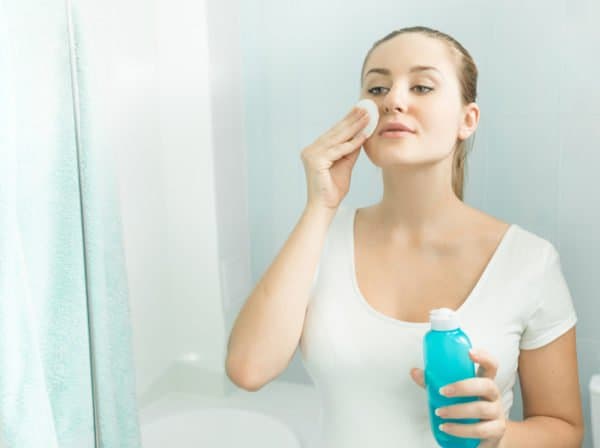Every woman wants flawless skin. But sometimes, our skin just doesn’t cooperate. Acne breakouts are one of the most common skin problems. And let’s face it acne can be frustrating and mar your complexion for life. While there are many solutions for acne, the best thing you can do is prevent it from happening in the first place.
If you have acne prone skin, here are six simple steps to help you.

- Start With A Cleanser
We live in a polluted world. At the end of the day rub a wet cotton swab on your skin and watch the grime come off even if you’ve been sitting in an office for the most part of the day. The biggest defense organ in our body is our skin. It fights dirt, microbes, and pollutants. Add to that your own makeup, dirt from your fingers, sebum, and sweat. Your skin is a playground for dirt and bacteria.
Using a cleanser daily in the morning and night can help keep your pores clean and free of dirt. This allows your skin to breathe and clear out any nidus of infection, blackheads and sebaceous secretions. Try using a cleanser that isn’t too drying and is gentle on your skin or a mild anti-acne face wash leaving your skin super soft after a cleanse.
When purchasing this type of skincare product, natural is always better. You may find cosmetic companies like Osmosis Skincare Australia that use organic ingredients in their products, which could help your skin to be less prone to breakouts.
- Practice Exfoliation
Exfoliation is the process by which you can remove the outer layer of dead skin cells. Why is this important? If you already have a deep-seated blackhead or a blocked sebaceous gland in your skin, a cleanser will not remove this. These clogged pores then become a breeding ground for bacteria, leading to acne.
You can practice exfoliating twice a week. If you want to know how to choose one, then here’s some advice from the American Academy of Dermatology. Exfoliation can reduce the number of breakouts through this deep cleaning method.
A word of caution, there are many scrubs available in the market and they can be harsh that will further irritate and inflame your skin. So go easy on the exfoliant. A little goes a long way here.
- Rejuvenate with Serum
Most people wonder about the position of serum in a routine. So remember this, after a cleanser and before the moisturizer. A serum has to be chosen based on your skin’s needs. For acne-prone skin, you should choose a serum that has vitamin C— as it repairs skin, retinol which increases cell turnover, zinc which regulates sebum and oil production, and salicylic acid which clears pores.
You can also look for serums with hyaluronic acid. It will replenish your skin’s moisture, and as we know, dry skin can also lead to breakouts. How? When the skin is dry, it produces more sebum to make up for moisture loss. Excess sebum then clogs pores, allowing bacteria to grow and leading to acne.
Serums can be pricey, but they are quite potent. You may require a few drops to cover your entire face.
- Hydrate Your Skin
The most important step in any skincare routine is hydration. Skin that is too dry or too oily can breakout faster. So hydrating the skin with a good moisturizer is a great way to keep the skin moist and healthy. It helps to lock in the serum’s nutrients and helps your skin to absorb it better.
You will find that with hydration your skin heals faster, looks better and has fewer breakouts. Be careful with your choice of moisturizer. After application, it shouldn’t clog your pores and make your skin feel suffocated. Try a lightweight moisturizer that works well with your skin type. A gel-based moisturizer is generally helpful for acne-prone skin as it doesn’t add any extra oil and leaves an unwanted greasy residue.
- Natural Oil Treatment
Acne can also get aggravated by stress, diet, hormones and your menstrual cycle, so you will occasionally have a breakout. However, for these once in a blue moon zits or blemishes you can add a natural healing oil like rosehip or almond oil, as a spot treatment after your moisturizer. These oils are packed with nutrients and help soothe the skin, reducing redness and inflammation.
These don’t work overnight. So, don’t give up if you don’t see results immediately. Incorporate these oils into your nighttime skincare routine. Over time, you will notice the blemishes and marks fade as the color and size of the scars decrease.
- Detox with Masks
Masks are a good way of working on additional skin problems like wrinkles, fine lines, dullness, sagging and even act as a cleanser. Once a week you can apply a mask and leave it in for an hour to detoxify and recharge your skin.
A clay or charcoal-based mask is an excellent option to soak up the excess oil and sebum. You can even make your own mask with homemade ingredients. We’ve listed a few different masks that you can whip up in your kitchen and apply to your face to see a visible change.
A mask can be done weekly or fortnightly depending on your skin type.
Takeaway
This is a basic skin care routine that can help you reduce breakouts. You may also check proactive reviews to know what to do with your skin problem. Tell us if you have any different steps. We’d love to hear them.





















